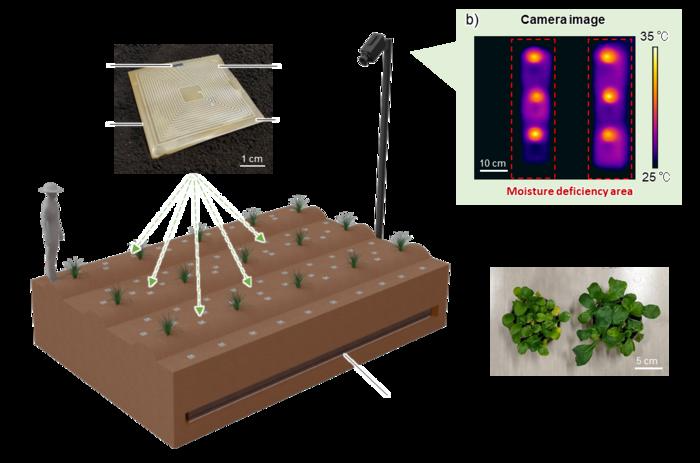
Proposed sensing system. a) Overview of the proposed sensing system with degradable sensor devices. b) When power is wirelessly supplied to the degradable sensor devices placed on the soil, the device heaters activate. The sensing location is determined from the hotspot location, and the temperature of the heater varies with the soil moisture content; thus, the soil moisture content is measured from the hotspot temperature. c) The degradable sensor devices are tilled into the soil after use. Subsequently, fertilizer components in the substrate of the sensor device are released into the soil, stimulating crop growth. Image Credit: 2023 Kasuga et al., Wirelessly powered sensing fertilizer for precision and sustainable agriculture. Advanced Sustainable Systems
With a growing global population, it is critical to maximize agricultural output while minimizing land and water consumption. Precision agriculture tries to address these competing requirements by utilizing sensor networks to collect environmental data to correctly allocate resources to crops when and where these resources are required.
Drones and satellites can collect a lot of data, but they are not great for determining humidity and soil moisture levels. Moisture sensing devices must be deployed in high density at ground level for optimal data collection.
If the sensors are not biodegradable, they must be collected at the end of their service life, which can be time-consuming and inconvenient. The current approach aims to provide both electronic functioning and biodegradability in a single technology.
Our system comprises several sensors, a wireless power supply, and a thermal camera for acquiring and transmitting sensing and location data. The in-soil components are largely ecofriendly; composed of a nanopaper substrate, a natural wax protective coating, a carbon heater, and tin conductive lines.
Takaaki Kasuga, Study Lead Author and Assistant Professor, Osaka University
The concept is based on the idea that the effectiveness of wireless power transfer to the sensor is proportional to the temperature of the sensor’s heater and the moisture content of the surrounding soil. For example, raising the soil moisture content from 5% to 30% on smooth soil reduces transmission efficiency from ~46% to ~3% at optimum sensor placements and angles.
A thermal camera then takes images of the region to obtain soil moisture content data as well as sensor location data. The sensors can be tilled into the soil for biodegradation at the conclusion of the crop season.
Kasuga added, “We have successfully visualized areas of soil moisture deficit by using 12 sensors in a 0.4-meter by 0.6-meter demonstration field. "Thus, our system works at the high sensor densities needed for precision agriculture.”
Precision agriculture might benefit from this effort in light of the world's growing resource constraints. It might be easier for the international agricultural community to adopt the researchers’ technology widely if it performs optimally under less-than-ideal circumstances (like uneven sensor positions and angles on rough soil) and perhaps for other soil environmental metrics besides soil moisture levels.
Journal Reference
Kasuga, T., et al. (2023) Wirelessly Powered Sensing Fertilizer for Precision and Sustainable Agriculture. Advanced Sustainable Systems. https://doi.org/10.1002/adsu.202300314